Different 3D printer filament types have different physical properties and different uses. In this article, we will take a look at 5 of the most popular types of filaments - TPU, PVA, PA, PC, and composite PLA - and discuss the 3D printer filament uses in practical scenes.
1. 3D printer filament type: TPU
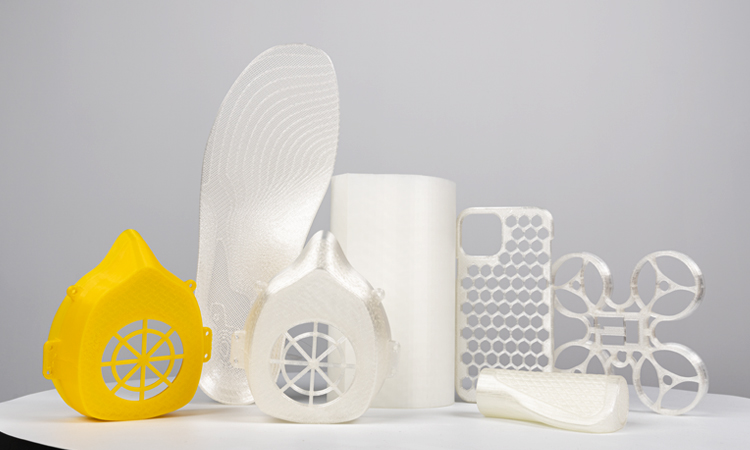
▲ TPU filament printouts
TPU is a high-strength flexible filament, one of the TPE thermoplastics and polyurethane in material essence. Compared with traditional physical materials such as PLA, ABS, TPU is a material showcasing elasticity and flexibility, feeling like tough rubber.
Using 3D printer filament type TPU for 3D printing, there is almost no odor. Because of the low shrinkage properties of TPU material, 3D printed TUP objects show good stability in dimensional size, which in a great deal reduces failure application caused by print size shrinkage.
3D printer filament uses TPU
Due to its good tolerance to weather erosion and outside wear, 3D printer filament TPU is widely used for making parts applied in the automobile industry, footwear components, and spare parts for medical facilities. Also, a good choice for model prototyping.
3D printing tips of TPU
To print 3D printer filament type TPU, please select a 3D printer with a direct-motion-drive extruder and with cooling fans. The function of cooling fans is to cool down the hot biting gear inside the extruding system, but not be used to directly blow and cool the printed model.
Flashforge 3D printers able to meet those TPU print requirements are Creator Pro, Dreamer, Dreamer NX, Guider 2, Finder 3, Creator 4, etc.
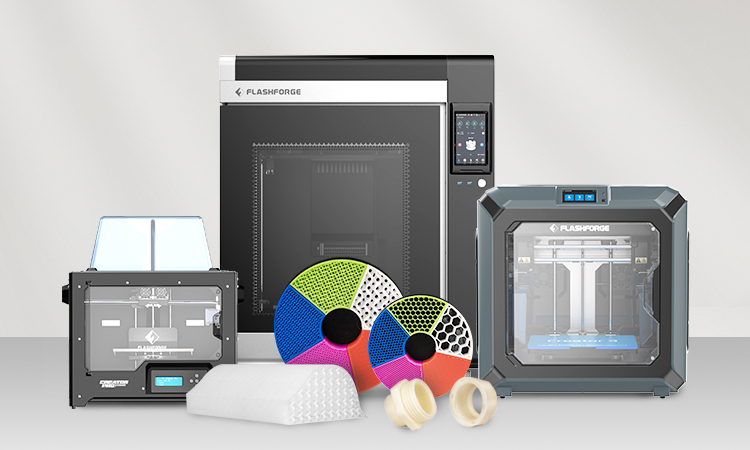
▲ 3D printers compatible with TPU
More print tips:
- Layer thickness: more than 0.1mm;
- Printing temperature: 220 - 240°C
- Build bed temperature: 70°C - 90°C
- Print speed: 30mm/s or less.
2. 3D printer filament type: PVA
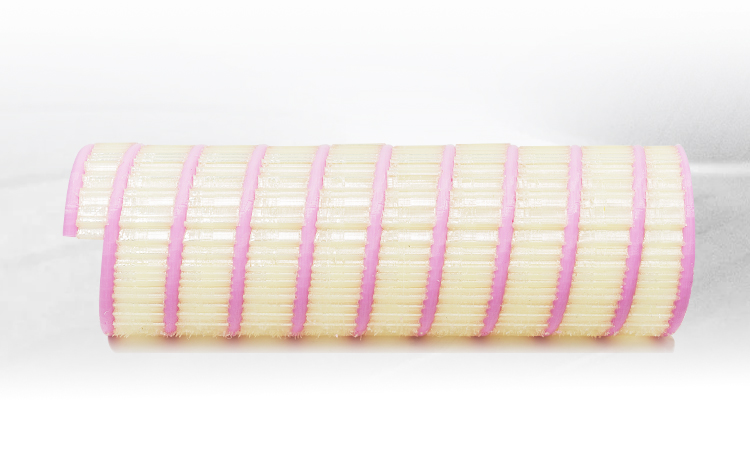
▲ PVA as model support
PVA material is a water-soluble polymer with a wide range of uses. 3D printing filament type PVA could completely dissolve in normal water and dissolves faster in hot water. It’s non-toxic and non-irritating to the skin. The touch feeling of 3D printed objects of PVA filament is what between plastic and rubber.
3D printer filament uses PVA
Owning to its water-soluble properties, the 3D printer filament type PVA is always used to print model supports. Each 3D printer user knows that support structures are necessarily needed when printing a model that has some body parts dangling in the air. PVA, as one of 3D printer filament types, is perfect for support printing. When finishing print soak the printout object into water. The support structures will dissolve and automatically separate from the model body after some time!
3D printing tips of PVA
Of course, in such situation, users need a dual-extruding 3D printer, with one nozzle printing model body and the other nozzle printing supports. Flashforge 3D printers able to do that include Creator Pro, Creator Pro/Max 2, Creator 3, Creator 4, etc.
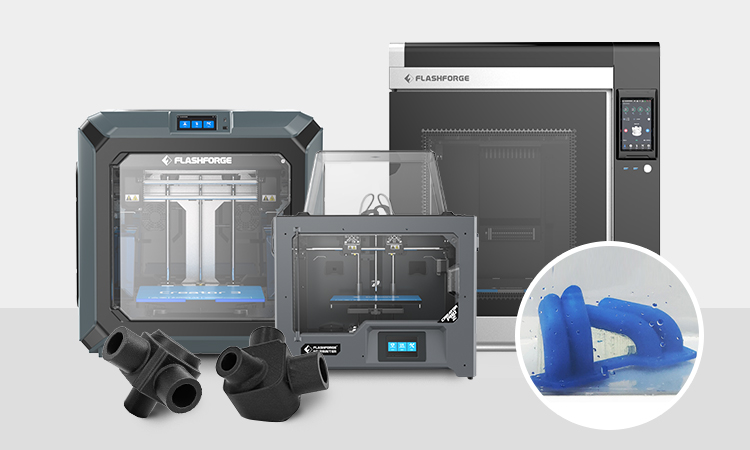
▲ Flashforge printers print with 2 nozzles
As to which types of filaments are proper for model body printing, here is the suggested PLA filament. The printing temperature of PVA is close to that of PLA and PVA has better viscosity with PLA than other materials.
If encountering non-smooth extruding or the viscosity to the model body is not enough, users please try to raise print temperature a little bit. PVA type of 3D printer filament is super absorbent and easy to get moisture, so please use it up as soon as possible once opened the filament package.
More print tips:
- Printing Temp: 190-230℃
- Heated Bed: Max. 45℃
- Well seal it when in no use
- Once getting wet please use a dryer station to dry it.
3. 3D printer filament type: PA
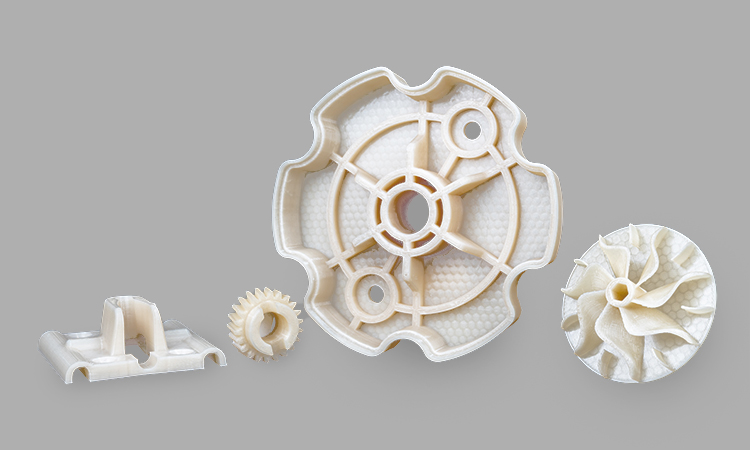
▲ PA/nylon print parts
What's PA (polyamide) material? People may be unfamiliar with this PA word, but they much have heart nylon. Yes, PA is commonly called nylon. 3D printed objects of PA/nylon filament are excellent in terms of strength, flexibility, and durability.
An honest fact about 3D printing filament types PA/nylon is that not all filament 3D printers support PA/nylon printing and not all PA/nylon filament products sold in the market are qualified to approach successful print. Some filament manufacturers buy nylon granules and produce PA/nylon filaments by using a processing method similar to the production of PLA filaments. The PA/nylon printer filament types produced in such a way will lead to failure print on almost all ordinary FDM 3D printers.
Luminary 3D printing manufacturers will ameliorate production methods of PA/nylon filament so as to get it compatible with most FDM 3D printer equipment. Users please carefully read the filament product info before purchasing.
3D printer filament uses PA
For a good use of 3D printer filament PA, users firstly need to select the right 3D printer. To meet people's demand for printing PA/nylon types of filaments, Flashforge, after going through many difficult technical barriers and R&D tests, has developed some good 3D printers that not only print PA filaments very well but also well print PA composites.
- Creator 3 3D printer: PA
- Guider 3 Plus 3D printer: PA, PA-CF, PA-GF
- Creator 4 3D printer: PA, PA-CF, PA-GF
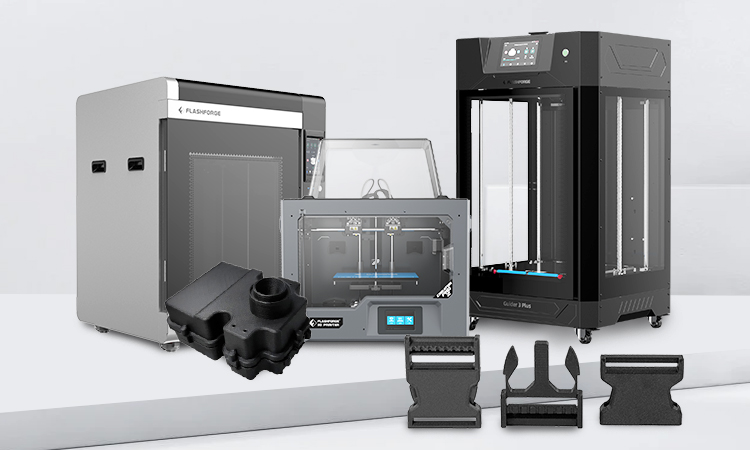
▲Flashforge 3D printers meet PA printing needs
The surface of print pieces made from 3D printing filament type PA material is smooth, and tolerant to heat and chemicals. It’s good for printing industry-use spare parts such as pump impeller, valve seat, bearing, instrument panel, air regulating valve, etc.
3D printing tips of PA
High-temperature PA/nylon printing is quite difficult. It is currently the most difficult to print among all FDM filament types. To print it well, you first need to choose a printer that supports PA types of 3d printing filament. Secondly, make correct slice settings.
In general cases, you only need to use the slicing software that officially matches the printer. if a printer supports PA filament printing, the slicing parameters for PA filament printing will be set well by default in the officially matched 3D printer slicer. For instance, if you purchased a Flashforge Creator 4 3D printer which supports printing PA, PA-CF, and PA-GF, you can directly use its matched official slicer - FlashPrint - to achieve high-rate successful printing. The slicer setting of PA print in FlashPrint is well set by default for Flashforge 3D printer types.
4. 3D printer filament type: PC
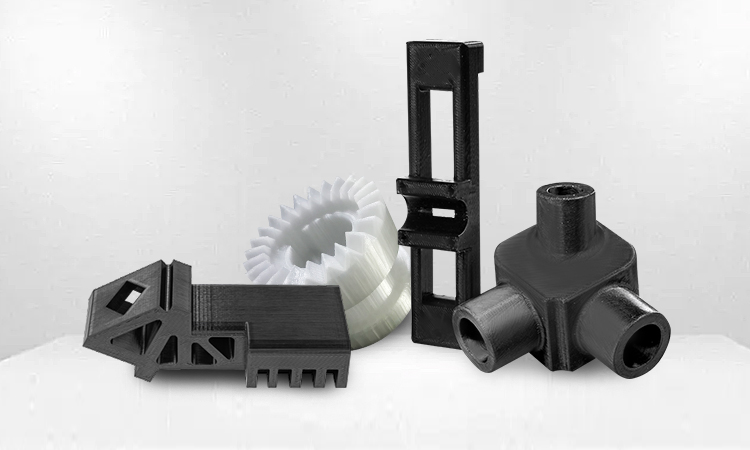
▲ PC printing parts
PC is one of commonly used industrial 3D printer filament types. It proposes very high strength, about twice the strength of ABS, able to tolerate high temperature up to 120 ℃. Compared with other 3D printing filament types, PC has poor fluidity and is difficult to print. PC also has good flame retardant performance, with flame retardant level reaching UL94-V2.
3D printer filament uses PC
The 3D printer filament type PC can endure long-time work at temperature over 100℃, so it’s good for making small parts on electronics, impact-tolerant auto parts, or high-temperature parts in aerospace fields.
3D printing tips of PC
PC is an environmentally friendly material and has no odor when printing. When selecting a PC filament product, users please pay some attention to its fluidity. Choose the one with better fluidity and easier to mold. PC type of 3D printer filament printing needs a high temperature.
More print tips:
- The printing temperature: 230-280℃.
- Platform temperature: +100°C. 120°C is recommended.
- Thermal insulation printing.
- Enclosed chamber 3D printer recommended.
5. 3D printer filament type: composite PLA
Tutorial on PLA filament print has been a cliche, and here let’s learn something about composite PLA. Here composite PLA means 3D printer filament types of PLA mixed with other materials like metal and wood. The percentage is around 70% PLA material and 30% wood/metal powder. The ratio may vary due to different performance requirements.
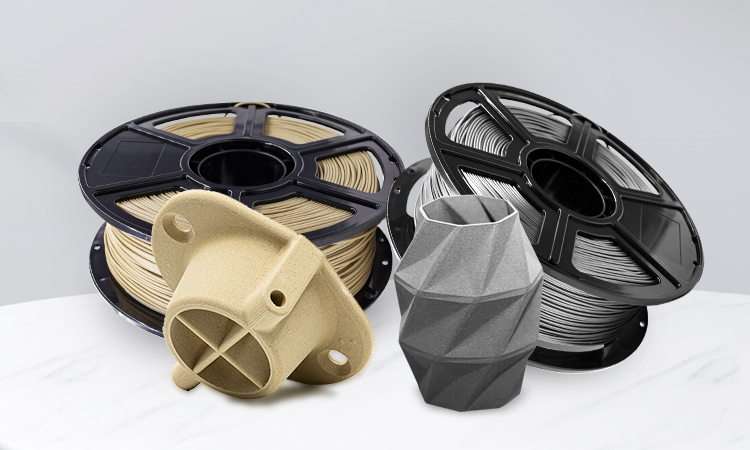
▲ wood PLA & metal PLA
3D printer filament uses composite PLA
Wood PLA filament is good to display a wooden texture when printing models, like trees, flower pots, and miniature buildings which need to resemble real-world natural objects.
3D printer filament types metal PLA, including copper PLA, silver PLA, bronze PLA, etc, prints out objects with the surface look metallic. The outer appearance of metal PLA printed objects is just like real metal, but their strength and toughness are far less. So stage performance props of metal arms and industrial craft modes are the better application cases of metal PLA.
Finishing words
In conclusion, this article introduced 5 3D printer filament types and uses. TPU is a good choice for printing flexible and elastic models. PVA is soluble in water, making it perfect for support material. PA and PC have high strength and are able to tolerate high temperatures, perfect for printing industry-use parts. And finally, wood PLA filament prints out objects with the surface look wooden, while metal PLA offers a metallic finish that is indistinguishable from real metal. All of these types of filaments have their own unique benefits and uses, so it is important to do your research before selecting the right types of filaments one for your needs. Flashforge offers premium 3D filament of PLA, ABS, PETG, and ASA. Welcome your visit!
Guess you like reading:
Which 3D printer materials should you use for your printing?
How to properly select a 3D printer filament?
My first try 3D printing try of TPU filament and ASA filament
How many types of Flashforge 3D printers are there?












